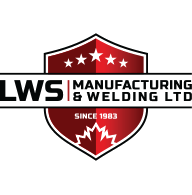What PPE is Required When Welding?
Personal protective equipment (PPE) should always be worn while welding. Failure to wear proper PPE can substantially increase the risk of injury while on the job whether you are a novice welder or an experienced veteran. As a leading provider of fabrication and welding services, the team at LWS Manufacturing & Welding knows how important PPE is for every project. That is why we have provided some information to help you understand what PPE is required when welding to minimize the risk of injury.
Read our welding safety tips to stay safe while on the job.
5 Key Pieces of PPE for Welding
Every welder should always wear the following PPE items before they operate any equipment:
1. Eye & Face Protection
A welder’s eyes and face must be sufficiently protected against UV exposure, hot metal, flash burns, sparks, and flying objects. A welding helmet should always be worn to protect against these hazards and minimize the risk of injury. It is also recommended to wear safety glasses under your welding helmet to further increase protection, as you may need to raise your helmet to perform inspections or other work.
2. Hand Protection
Since your hands will be extremely close to the materials you are welding, hand protection is vital. Welders should always wear heat-resistant gloves that go up to the elbows to minimize the risk of burns and other injuries. When purchasing gloves, it is also worth considering mobility and dexterity as you will need to make precise movements throughout the day. In some situations, you may need to switch between various types of gloves depending on the project. For example, you may need cut-resistant gloves for one project and gloves with extremely high heat resistance for another.
3. Fume Protection
Toxic fumes, gases, and dust are often produced when welding. To ensure optimal safety, all welders should have a fan, exhaust system, or exhaust hood in place to remove harmful fumes before they can be breathed in. Employers may also need to provide respiratory equipment for certain environments to further reduce the risk of injury.
4. Foot Protection
All welders should wear steel-toed leather boots to protect against heat, sparks, falling objects, and hot metal. Welding spats and other heat-resistant foot/leg coverings can also be worn for additional protection against heat and sparks.
5. Ear Protection
Ear/hearing protection may be required in loud work environments. If a welder is consistently exposed to noise hazards above 85 decibels, their employer must provide sufficient hearing protection to minimize the risk of hearing loss.
It is crucial to note that all PPE must meet or exceed relevant CSA standards for welding. If an item does not meet or exceed these standards, it is not suitable for welding applications.
To learn more about welding safety or to inquire about our metal services, get in touch with the team at LWS Manufacturing & Welding. We can be reached through our online contact form and will be happy to answer any questions you may have regarding our services or the details of your project.
